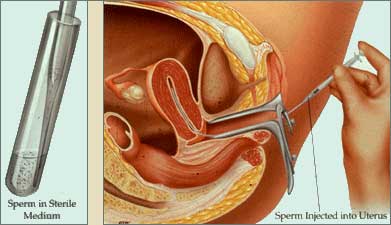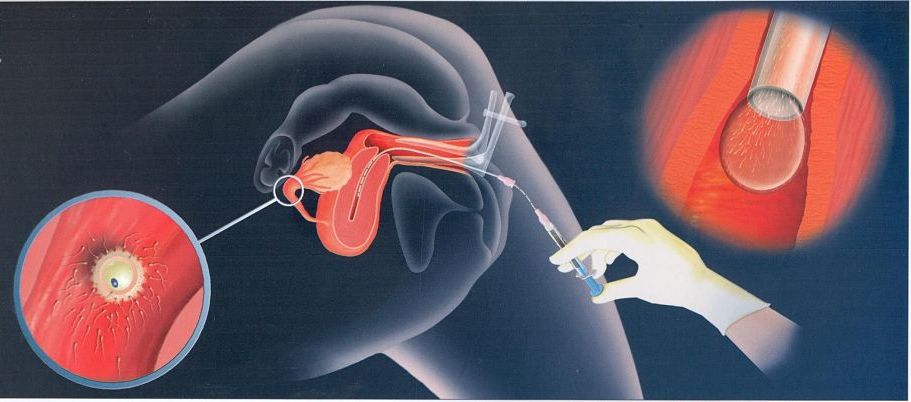Welcome To Chhabra Hospital & Test Tube Baby Centre
 Intrauterine insemination (IUI) — a type of artificial insemination — is a procedure for treating infertility. Sperm that have been washed and concentrated are placed directly in your uterus around the time your ovary releases one or more eggs to be fertilized. Older types of artificial insemination placed the sperm in the vagina. While this was easier, it was not as successful as the current procedure.
Intrauterine insemination (IUI) — a type of artificial insemination — is a procedure for treating infertility. Sperm that have been washed and concentrated are placed directly in your uterus around the time your ovary releases one or more eggs to be fertilized. Older types of artificial insemination placed the sperm in the vagina. While this was easier, it was not as successful as the current procedure.
The hoped-for outcome of intrauterine insemination is for the sperm to swim into the fallopian tube and fertilize a waiting egg, resulting in a normal pregnancy. Depending on the reasons for infertility, IUI can be coordinated with your normal cycle or with fertility medications.
Why it's done
A couple's ability to become pregnant depends on many different factors. Intrauterine insemination is used most often in couples who have:
- Donor sperm. For women who need to use donor sperm to get pregnant, IUI is most commonly used to achieve pregnancy. Frozen donor sperm specimens are obtained from certified labs and thawed before the IUI procedure.
- Unexplained infertility. IUI is often performed as a first treatment for unexplained infertility along with ovulation-inducing medications.
- Endometriosis-related infertility. Like unexplained infertility, the combination of medications to obtain the best egg and IUI is the first treatment.
- Mild male factor infertility (subfertility). Your partner's semen analysis, one of the first steps in the medical assessment of infertility, may show below-average sperm concentration, weak movement (motility) of sperm, or abnormalities in sperm size and shape (morphology). IUI can overcome some of these problems because preparing sperm for the procedure helps separate the highly motile, normal sperm from those of lower quality. This works best if the sperm have only one abnormality, such as only a motility problem.
- Cervical factor infertility. Your cervix is at the lower end of the uterus and provides the opening between your vagina and uterus. The mucus produced by the cervix around the time of ovulation is supposed to provide an ideal environment for sperm to travel from your vagina to the fallopian tubes. However, if the cervical mucus is too thick, it may impede the sperm's journey. IUI bypasses the cervix, depositing sperm directly into your uterus and increasing the number of sperm available to meet the awaiting egg.
- Semen allergy. Rarely, women have an allergy to proteins in their partner's semen, so ejaculation into the vagina causes redness, burning and swelling where the semen has contacted the skin. A condom can protect you from the symptoms, but it also prevents pregnancy. If your sensitivity is severe, IUI can be effective, since many of the semen proteins are removed before the sperm is inserted.
 Risks
Risks
Intrauterine insemination is a relatively simple and safe procedure, and the risk of serious complications is low. Risks include:
- Infection. Studies indicate that fewer than 1 percent of women experience infection as a result of the procedure.
- Spotting. Sometimes the process of placing the catheter in the uterus can cause a small amount of vaginal bleeding. This does not usually have an effect on the chance of pregnancy.
- Multiple pregnancy. IUI itself is not associated with an increased risk of a multiple pregnancy — twins, triplets or more. However, when coordinated with ovulation-inducing medications, the risk of a multiple pregnancy increases significantly. A multiple pregnancy has higher risks than a single pregnancy does, including early labor and low birth weight.
How you prepare
Intrauterine insemination involves careful coordination before the actual procedure.
- Preparing the semen sample. Your partner provides a semen sample at the doctor's office, or a vial of frozen donor sperm can be thawed and prepared. Because nonsperm elements in semen can cause reactions in the woman's body that interfere with fertilization, the sample will be washed in a way that separates the highly active, normal sperm from lower quality sperm and other elements. The likelihood of achieving pregnancy increases by using a small, highly concentrated sample of healthy sperm.
- Monitoring for ovulation. Because the timing of IUI is crucial, monitoring for signs of impending ovulation is critical. This can be done by using an at-home urine ovulation predictor kit which detects when your body produces a surge or release of luteinizing hormone (LH). Alternatively, an imaging method that lets your doctor visualize your ovaries and egg growth (transvaginal ultrasound) can be done. If you choose to use an ultrasound to monitor ovulation, you may be given an injection of human chorionic gonadotropin (HCG) to make you ovulate one or more eggs at the right time.
- Determining optimal timing. Most IUIs are done a day or two after detecting ovulation. Your doctor should have a plan spelled out for the timing of your IUI.
What you can expect
The visit for intrauterine insemination takes about 15 to 20 minutes and is usually done in a doctor's office or clinic. The IUI procedure itself takes just a minute or two and requires no medications or pain relievers. Your doctor or a specially trained nurse performs the procedure.
During the procedure
While lying on an exam table, you'll put your legs into stirrups and a speculum will be inserted into your vagina — similar to what you experience during a Pap test. During the procedure, the doctor or nurse:
- Attaches a vial containing the small sample of healthy sperm to the end of a long, thin, flexible tube (catheter)
- Inserts the catheter into your vagina, through your cervical opening and into your uterus
- Pushes the sperm sample through the tube into your uterus
- Removes the catheter, followed by the speculum
After the procedure
After insemination you'll be asked to lie on your back for a brief period. Once the procedure is over, you can get dressed and go about your normal daily activities. You may experience some light spotting for a day or two after the procedure.
Results
Wait two weeks before taking an at-home pregnancy test. Testing too soon could produce a result that is:
- False-negative. If your hormone levels are not yet at a measurable level, the test result may be negative when, in fact, you really are pregnant.
- False-positive. If you're using ovulation-inducing medication such as HCG, the medication that's still circulating in your body could indicate a pregnancy when you really aren't pregnant.
Your doctor may instruct you to return about two weeks after your home kit results for a blood test, which is more sensitive in detecting pregnancy hormones after fertilization.
If you don't become pregnant, you might try IUI again before moving on to other fertility treatments. Often, the same therapy is used for three to six months to maximize chances of pregnancy.
 Intrauterine insemination (IUI) — a type of artificial insemination — is a procedure for treating infertility. Sperm that have been washed and concentrated are placed directly in your uterus around the time your ovary releases one or more eggs to be fertilized. Older types of artificial insemination placed the sperm in the vagina. While this was easier, it was not as successful as the current procedure.
Intrauterine insemination (IUI) — a type of artificial insemination — is a procedure for treating infertility. Sperm that have been washed and concentrated are placed directly in your uterus around the time your ovary releases one or more eggs to be fertilized. Older types of artificial insemination placed the sperm in the vagina. While this was easier, it was not as successful as the current procedure. Risks
Risks

